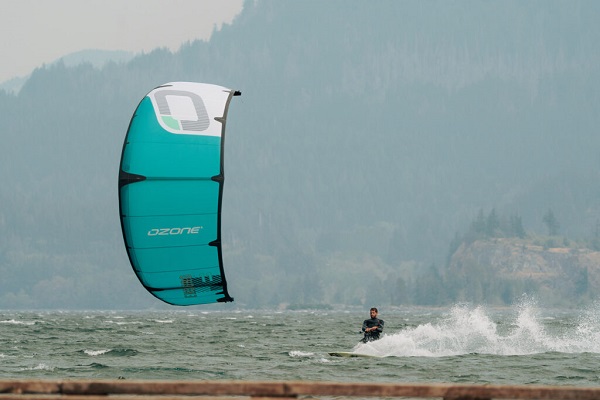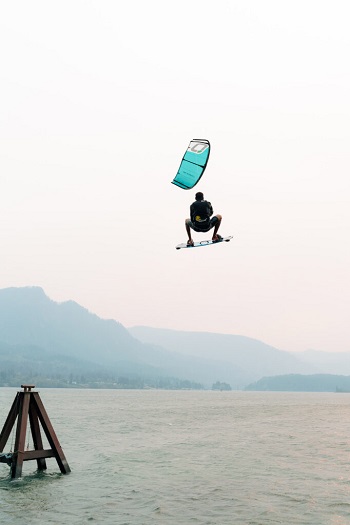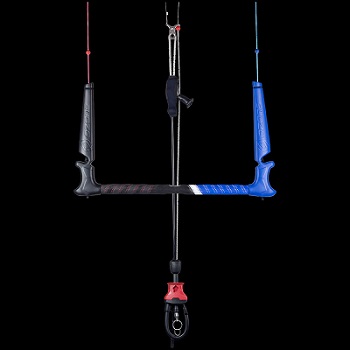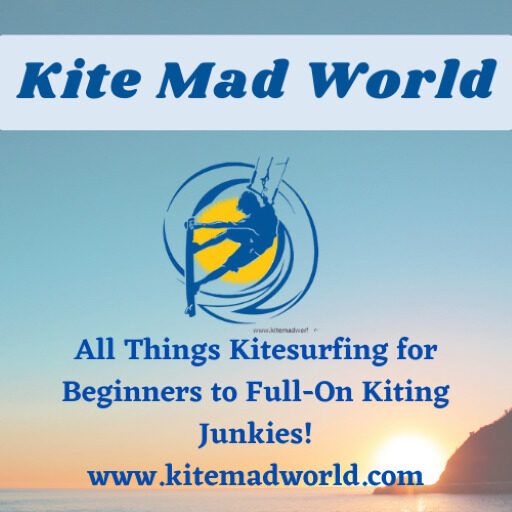We got hold of the brand new V4 recently to test out and put through its paces. And I’m still smiling as I write this! This Ozone Enduro V4 review looks at how it fits into your quiver.
The Ozone Enduro V4 is pitched by Ozone as their go-to all-round kite suited to the rider who wants one kite to cover all disciplines, from free-ride and boosting to wave and foiling, and with the option to go free-style with explosive unhooked tricks.

Who are Ozone
Ozone has been at the forefront of kiting since the beginning. Owned by 3 Brits who now live in New Zealand, all the manufacture takes place in their own state-of-the-art factory in Vietnam.
What I like about Ozone is their no-nonsense approach to kite design. They don’t launch a new version of a kite unless there is a significant improvement to be had. And every part of the kite serves the purpose of improved performance.
What’s Different About the Enduro V4?
The Enduro has been around for a few years and has been well-loved by its riders. On the V4, Ozone have re-designed the leading edge and canopy to make the kite even more stable in gusts and under pressure.
Ozone say that the technology that’s gone into the leading edge construction allows smoother air-flow and the result is better aerodynamics to give it more wind range and smoother performance.
As you would expect from a top-end kite manufacturer, the materials used are the best available. And I have to say that when it comes out of the bag the canopy looks and feels right up there.
The kite is designed to excel in all disciplines and has 3 bridle settings, branded by Ozone as “Variable Bridle Geometry (VBG). There are wave, free-ride and free-style settings. Switching between them is a 30 second job, you just undo a larks head where the bridle attaches to the leading-edge and move the knot up or down the pig-tail to the appropriate knot.
The kite comes by default on the free-ride setting, which is how I flew it. In addition there are 3 steering line adjustments to increase or decrease turning-speed and bar-pressure.
The rep from Ozone had left the kite on wave setting before he realised and suggested I change it, so I can report the difference in feel.
How Does it Fly?
I took the 9m version out to play in winds that were a constant 25kts with squalls gusting up to 35+kts. So testing conditions.
Settings
As I said, the rep had left the VBG setting on “wave” and to start with the kite felt a little under-powered for a free-ride. But, once I realised why, it made sense.
In the wave setting I was still moving along at a decent pace and tracking upwind into fairly choppy water, but the bar-pressure was less and the kite didn’t feel grunty in the gusts. In the lulls it drifted nicely and was still easy to turn.
But as soon as I swapped the setting to free-ride it was a whole different ball-game!
In the Air
The Enduro V4 delivers plenty of punch even at the lower end of the range I would normally fly a 9m. And at the top-end of the range it just felt completely in control. The throw on the de-power line is relatively short but smooth and progressive and I felt I could have happily kept control in even stronger winds.

The Enduro is a 3-strut kite and has an Open-C profile with fairly square wing-tips and a short pulley-less bridle.
Ozone have also done work on the canopy design to give it a cleaner curve with less air friction over the upper side of the canopy. They’ve added panels to the leading edge and reinforced the trailing edge to reduce flapping and wear.
These features keep the canopy tight and stable and give it a playful feel so it turns exactly when you want it to and loops easily and progressively.
As with most Open-C kites, you have to get the timing right if you want to hit the Woo records, compared to all-out boosting kites like the Ozone Edge or Core XR7.
But it’s still very forgiving and delivers nice floaty jumps. I would say the hang-time felt better than with other kites designed as all-rounders.
What I really loved about the kite was its instant response to anything I did at the bar end, whether it be loops, sending it for a jump or sheeting in and out in the gusts. And it does all of it without any fuss. The squarish wing tips make it a doddle to re-launch too, with a simple pull on the bar.
The Bar

Ozone have only one bar option for their water kites, the Contact Water V4 and it comes in two fixed lengths, 45cm and 50cm. They say the 50cm is good for all kite sizes from 8m upwards. I used the 45cm bar with the 9m and it worked perfectly, although I do favour a shorter bar length anyway.
The bar is clean, comfortable and has no fussy parts that add to weight and potential failure. The center lines meet at a “low V” just above the trim strap and come in standard 25m length with 500kg breaking strain on the power lines and 300kg on the steering lines.
It has a rotating head just above the QR to easily untwist the lines after a rotation and the QR has a simple click-in mechanism to re-load after a release.
We’ve been using the V3 version on our school kites for 2 years and I can vouch for the quality and user-friendliness of the lines and bars.
Build Quality
Ozone has a reputation for building robust kit, all their kites being built in their own factory under exacting quality controlled conditions. And this shows in the feel of the canopy and the noticeable reinforcement panels at all the stress and wear zones. They don’t scrimp on materials and I have no doubt that this version of the Enduro will still feel crispy after plenty of hard use.
They are at the top-end of the price range, but you really are getting your money’s worth with these kites.
How Does it Compare?
In my opinion the new Enduro is giving all the competition in the “all-round” category a run for their money. Having flown it myself, I’ll definitely have a hard choice to make between this and the Core Nexus when I change my personal quiver. It flies pretty much the same in free-ride mode and, if anything, felt a bit more “floaty” in the jumps.
And the Eleveight RS gives slightly more float, but doesn’t drift as easily for wave and foil riding.
Price-wise, the Enduro is very similar to the Core, although Ozone’s bars come in quite a bit cheaper. Both the Core and Ozone cost quite a bit more than the Eleveight RS range, but I believe that money would be recouped in re-sale value.
So it all comes down to how much you want to spend and whether you want to use it for foiling and wave riding. All three kites are suitable for a beginner looking to progress from independent riding to any level they aspire to and are equally suited to experienced riders who want an all-round do-everything quiver.
What is certain is that you won’t be disappointed with the quality and performance of the Enduro V4.



Just my opinion, for total beginners are a little too fast moving kites, I would aim to the Ozone Catalyst V3
Hi Gaetano,
I agree with you for absolute beginners. We use the Catalyst to teach with because it’s slower turning and super easy to relaunch. However, the article is aimed more at kiters who are moving on from basic learning and looking to buy a kite to progress with. Everyone’s idea of a beginner kite is slightly different. I think if someone has got to the stage in lessons of riding upwind and reasonable kite control, the slightly more advanced Nexus and Enduros will help them progress without having to buy a new quiver after a year or less.
But the Catalyst is a great kite, especially in lighter winds, and the range is amazing.